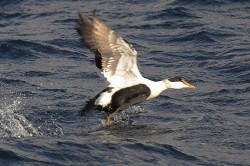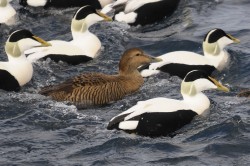Northern (borealis) Eiders
Posted by Brydon Thomason on Thursday 29th April 2010 | Birding in Shetland
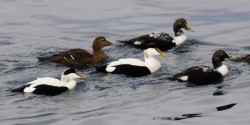
Taken in February 2008, in this photograph the ‘fairy cake wing’ scapular sails and the striking orangey yellow bill tones are quite obvious.
For the third consecutive winter I have been seeing birds ‘presumed to be’ of the form borealis also known as ‘Northern Eider’ amongst flocks of Common Eider in Bluemull Sound, the channel of sea which separates Yell, Unst and Fetlar. These really are stunning Eiders and with a keen eye are quite easily recognised amongst the ‘commoners’. My first experience of birds showing features of this form was in November 2007, since then there has been at least two wintering drakes returning, with up to four birds together in March 2009. This past winter (‘09/’10) two drakes wintered again, with at least one still present into mid April.
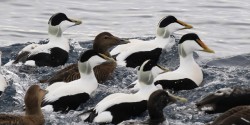
In this image, also taken in February 2008, the difference in bill colour (front right two drakes) to the accompanying Common Eiders is quite distinct.
Knowing that Martin Garner (who we are extremely fortunate to have leading tours with us) was probably the most informed Eider enthusiast in the nation, I emailed him images and so started my interest in the rarer forms of Common Eider.
Superficially the drakes are very similar to the dapper black and white plumage of our Common Eider but it is the small but rather elaborate ‘scapular sails’, which are often pert up like the little wings on a fairy cake and also the bright yellow tones of the bill that really set them apart.
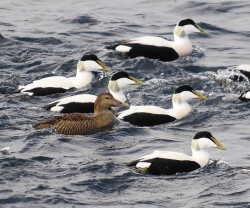
Taken in March 2009, this photo shows three fine drakes (and an apparent female too) which appear to be classic examples of Northern Eider, exhibiting all the key features and has been said to be potentially the best photographic record of them in British waters.
They are perhaps what you might say to be ‘birders birds’- birds that only really keen birders will look for and find interesting, even travel to see. This ‘Northern’ form also known as ‘Borealis’, (which is also the Latin name somateria mollissima borealis) is basically the name given to the subspecies in the Arctic regions of the North Atlantic, from North East Canada, Greenland, Iceland and Svalbard. It is possible and indeed quite likely that birds have been over looked in Britain in the passed.
It is currently very much regarded as a rarity in Britain and is a subspecies that is soon to be looked at in detail by the British Birds Rarities Committee in order for criteria to be put together on how to reliably identify and asses records of these vagrants amongst our Eider flocks and hopefully build a picture of their status, both here and where they originate from.
Through out the British Isles (and indeed many parts of Europe) when it comes to potential rare Eiders amongst our winter flocks, most birders are tuned into that oh so familiar and oh so delightful features of a resplendent drake King Eider, surely one of the Worlds most exquisite sea ducks. Some keener eyed and enthusiastic birders may also be on the look out for a female, ‘Queen’ Eider. Stellers Eider would of course be a dream find for any rarity hunter, as it remains a true Mega, surely we are long over due the next one? But now, with increasing knowledge and awareness of the rarer subspecies of Common Eider that could turn out to be much more sought after amongst birders in Britain.
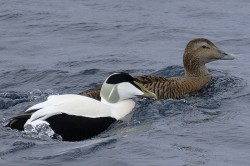
Taken more recently, this image as well as the one below from last year shows how the bill shape tends to differ structurally as well as by colour, tending to be more elongated and drooping towards tip. The shape of the lobes (the extremity of bill that runs up towards forehead) tends to be different as does the black that borders it.
There are several subspecies in the ‘Common Eider’ group, four of which we should (and many are) on the look out for as they could potentially turn up as vagrants in our flocks in Britain. ‘Northern’ Eider is by far the most likely target for the avid rarity hunter in Britain, as the form is known to occur in Scotland, the Northern Isles and Northern Ireland. The separation, identity and indeed taxonomy involving these forms is still a complex subject to say the least. Another subspecies from the group ‘Dreser’s Eider’ also known as ‘American Eider’ was recently recorded in Ireland, its first appearance in Europe! This is a revolutionary example of what might reach our British waters some day…


